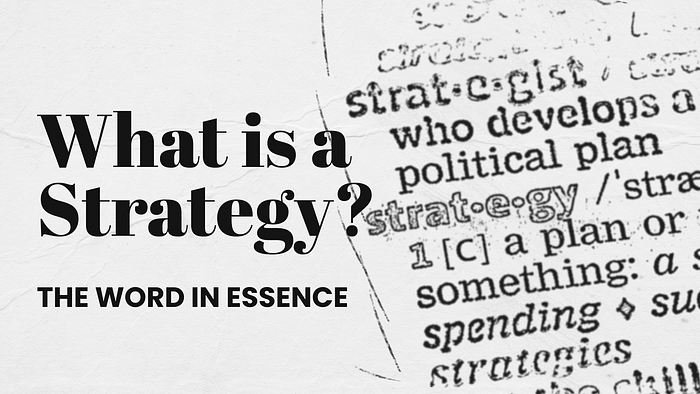The Meaning of Strategy — The Essence of the Word

This thing called “Strategy” is such a buzzword that started gaining momentum over the past decades, everyone seems to be attributing it to everything there is in life, from space explorations to the making of an egg omelet dish — seriously! I saw it on YouTube once where the cook literally used the word, but unfortunately, the meaning of the word is often misunderstood or unclear.
The confusion around the term “strategy” and the adjective “strategic” can be partly attributed to the fact that it is used in a variety of contexts, and this can make it difficult to understand exactly what the term means in any given situation. Additionally, some people use the term “strategy” simply to sound smart, without actually understanding what it means.
Many people also associate strategy with complex, carefully crafted long-term plans, and sophisticated approaches to achieving certain goals, but this is not necessarily the case. In fact, strategy is more about simplifying complex situations and finding a clear path forward.
DEFINING STRATEGY
Defining the concept of strategy is a subject that has been widely debated throughout history. While many individuals have attempted to explore this topic, a significant issue remains, the absence of a consistent and adequate vocabulary that is capable of effectively describing its nuances. It is easier to discuss “A Strategy” in the context-specific area rather than “Strategy” as a term in and of itself because it can be considerably more difficult to define and grasp in a more generalized form.
After an extensive review of existing literature and notable definitions, looking up its etymology, its history, reading many books and some of the best articles that have been written about it, and while I found value in many places I looked, I never felt that I had a single, comprehensive, and fully established answer to the question of what strategy is it.
Michael E. Porter, in his highly-regarded work “What is Strategy?” — HBR, 1996, put forward three definitions:
– Strategy is the creation of a unique and valuable position, involving a different set of activities.
– Strategy is creating fit among a company’s activities.
– And finally, The essence of strategy is choosing what not to do.
Martin Reeves, chairman of the BCG Henderson Institute and co-author of the book “Your Strategy Needs A Strategy” defines Strategy as a coordinated and integrated set of actions aimed at securing a sustainable competitive advantage
My favorite definition comes from none other than the #1 on the Thinkers 50 List for the year 2017: Prof. Roger L. Martin, who distills strategy primarily as choices. In his words: “A Strategy is an integrated set of choices that positions you on a playing field of your choice in a way that you win”. In other words, it is a theory about a set of choices out of many other possible choices that would put you in positions where you have more options than the competition does. It is when you say: here’s why I should be playing on this field, not this other one, and here’s how I am going to be better than anybody else on that playing field.
STRATEGY = CHOICES + ACTIONS
So, standing on the shoulders of giants, I came up with an equation that is concise, in an attempt to summarize the essence of strategy. At its core, strategy involves making choices about what goals to pursue, how to achieve them, and which resources to allocate toward that end. These choices are then translated into actions that are taken in the real world, whether in the context of a business, a military campaign, a competitive situation, or even the level of personal development.
The “Choices” component of this equation refers to the process of identifying and selecting the best possible course of action given the available options and constraints. This may involve conducting a thorough analysis of the external environment, such as market conditions, customer needs, and competitor strategies, as well as an assessment of the internal strengths and weaknesses of the organization or the individual making the strategic choices.
Once the optimal choices have been identified, the “Actions” component of the equation comes into play. This involves putting the chosen strategy into practice, allocating resources, and making decisions on a day-to-day basis that move the organization or individual closer to their goals. The actions taken must be well-coordinated, consistent with the chosen strategy, and adaptable in response to changing circumstances.
Overall, the equation “Strategy = Choices + Actions” highlights the interconnected nature of strategy and the importance of both making the right choices and executing them effectively. By focusing on both components of the equation — within a specific context — individuals and organizations can develop and implement effective strategies that lead to success.
CONCLUSION
The creation of effective strategies is an important and fundamental process that can lead to exceptional outcomes. Investing time and effort in developing a strategy can have life-changing results. By redefining the meaning of strategy, we are able to better understand its potential and harness its power to overcome significant challenges. It is thus imperative that we understand the distinction between strategies and tactics, and the need to prioritize the creation of an effective strategy to achieve desired outcomes.
